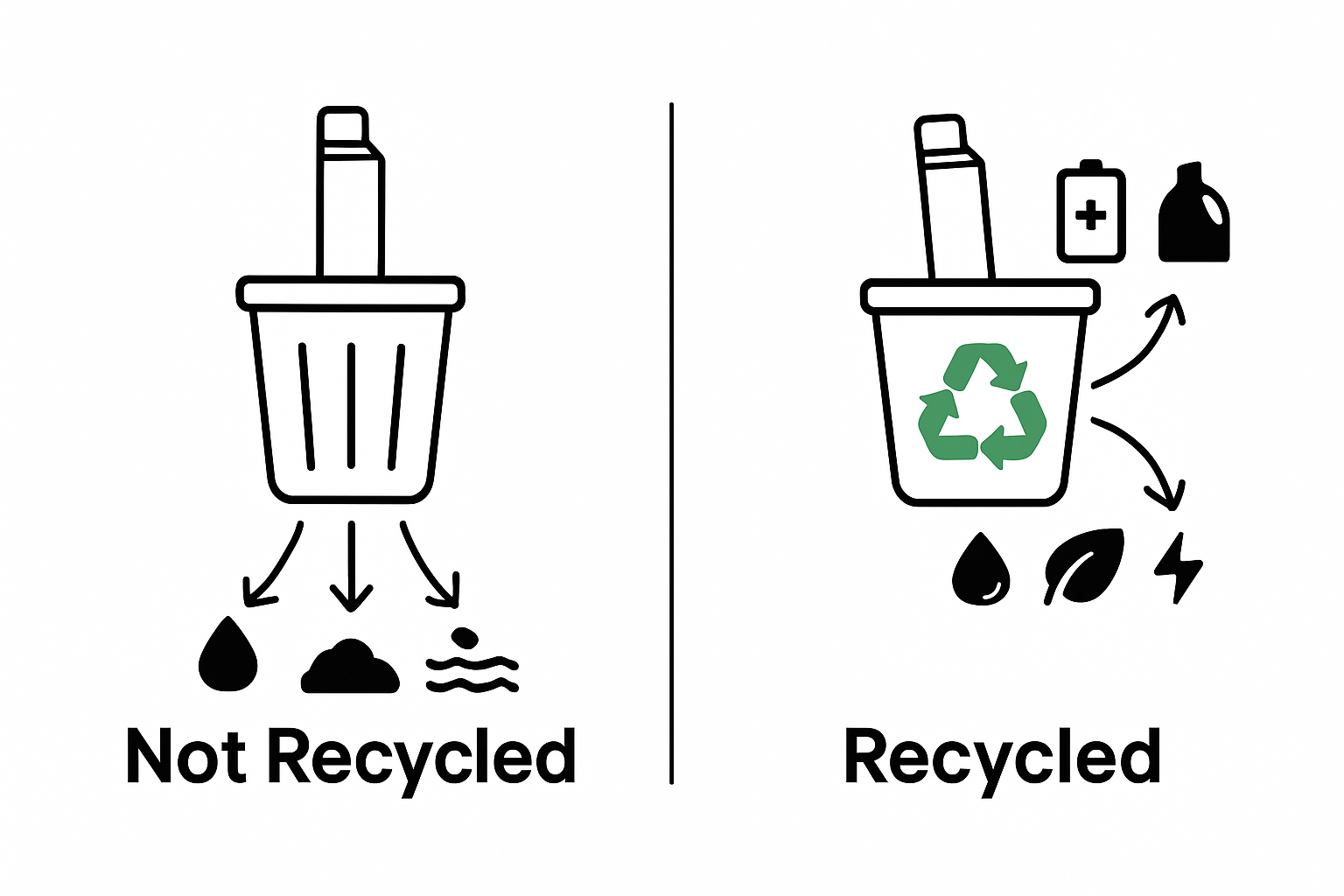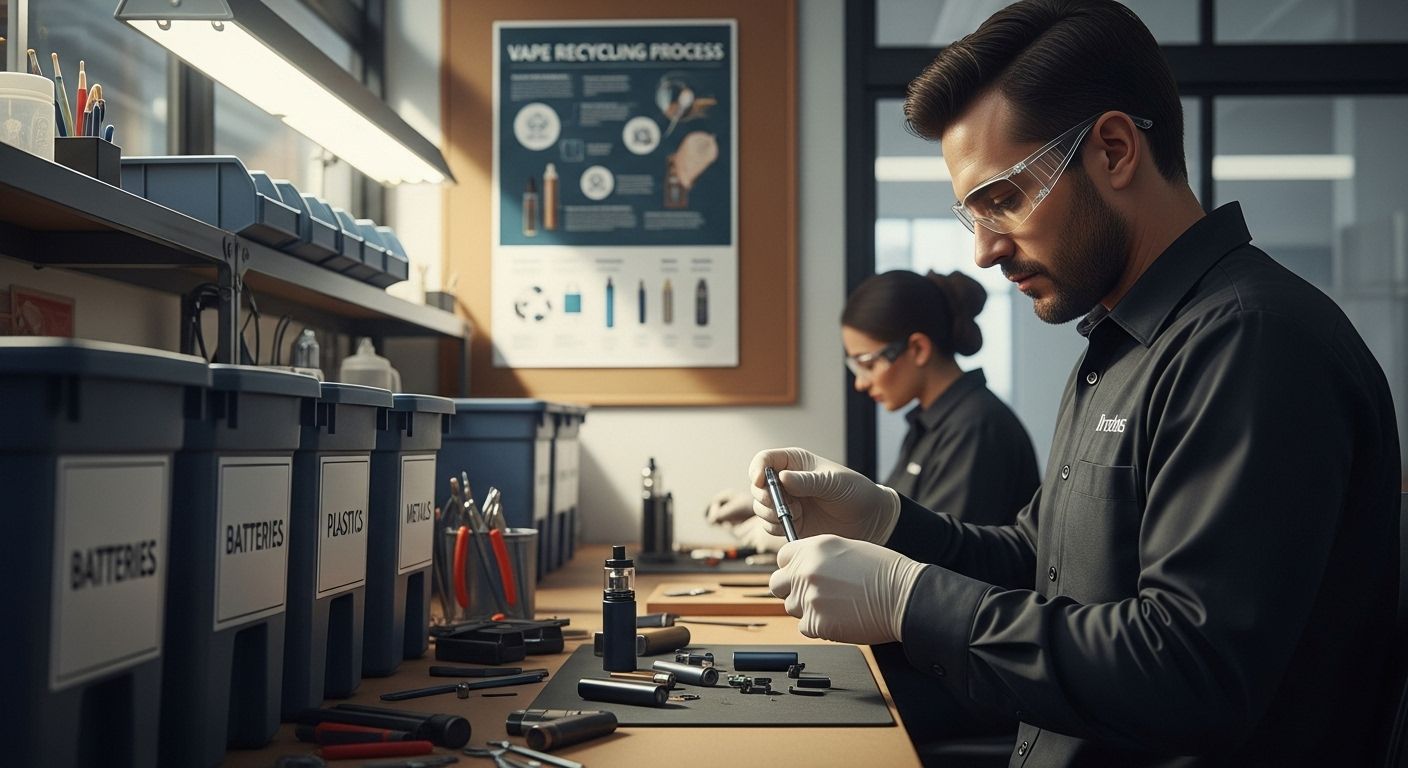Blog
What is Disposable Vape Recycling and Why It Matters
Disposable vapes have exploded in popularity, with millions of these tiny devices tossed out every week, adding up to a mountain of hidden electronic waste. Most people see them as simple and convenient, all smooth plastic and bold colors. But underneath that slick surface hides a cocktail of lithium batteries, toxic chemicals, and metals that can linger in the environment for years. The real surprise is just how much harm a single vape can cause after you throw it away.
Table of Contents
- Understanding Disposable Vapes: Composition and Waste
- The Importance of Recycling Disposable Vapes
- How Disposable Vape Recycling Works
- Key Concepts in Vape Recycling Practices
- Real-World Impact of Recycling Disposable Vapes
Quick Summary
| Takeaway | Explanation |
|---|---|
| Recycle disposable vapes responsibly | Proper recycling prevents toxic chemicals from contaminating soil and groundwater, addressing serious environmental risks. |
| Understand the components of vapes | Knowing the materials in disposable vapes helps highlight their environmental impact and waste management challenges. |
| Support specialized recycling programs | Engaging with programs designed for vape recycling contributes to resource recovery and reduces electronic waste. |
| Avoid improper disposal | Discarding vapes incorrectly can lead to ecological contamination and health risks, making responsible disposal critical. |
| Stay informed about recycling methods | Learning about the complex recycling processes enhances understanding of their importance and efficacy in waste management. |
Understanding Disposable Vapes: Composition and Waste
Disposable vapes represent a complex intersection of technology, convenience, and environmental challenge. These compact devices are more than just simple nicotine delivery systems. They combine intricate electronic components, chemical substances, and material designs that create significant waste management concerns.
Materials and Manufacturing Complexity
Each disposable vape typically consists of several key components that contribute to its environmental footprint. The primary elements include:
- Lithium-ion battery
- Plastic outer casing
- Electronic circuitry
- Heating element
- Prefilled e-liquid reservoir
These components are manufactured using materials that do not naturally decompose, creating long-term environmental challenges. According to research published by the National Institutes of Health, these devices contain toxic chemical residues and heavy metals that can leach into soil and water systems when improperly discarded.
Environmental Impact of Single Use Devices
The proliferation of disposable vapes has created a significant waste management problem. A single device might seem small, but millions of these products are discarded weekly, creating substantial electronic waste. The environmental consequences are profound:
- Non-biodegradable materials persist in landfills
- Toxic chemicals can contaminate groundwater
- Electronic components release harmful substances during decomposition
Learn more about responsible vape disposal practices to understand how individual actions can mitigate these environmental risks. Recognizing the composition and waste potential of disposable vapes is the first step toward developing more sustainable consumption habits.
To help clarify what makes disposable vapes environmentally challenging, the table below breaks down the key components found in most disposable vape devices and their potential environmental impacts.
| Component | Description | Potential Environmental Impact |
|---|---|---|
| Lithium-ion battery | Rechargeable power source | May leach toxic metals; risk of fire if not handled properly |
| Plastic casing | Outer protective body | Non-biodegradable; contributes to plastic pollution |
| Electronic circuitry | Microchips and wiring | Contains metals and chemicals; poses recycling difficulties |
| Heating element | Metal coil for vaporizing e-liquid | Can release metal particles; adds to electronic waste |
| E-liquid reservoir | Contains nicotine liquid | Residual chemicals may contaminate soil and water |

Comprehensive recycling and responsible disposal strategies are crucial in addressing the growing environmental challenges posed by these increasingly popular devices.
The Importance of Recycling Disposable Vapes
Recycling disposable vapes goes beyond simple waste management. It represents a critical environmental responsibility that addresses complex ecological and public health challenges. These small devices carry significant potential for environmental harm if not handled with careful consideration.
Environmental and Health Protection Strategies
Proper disposal of vapes is not just recommended but essential. The critical reasons for recycling include:
- Preventing toxic chemical leakage into soil and groundwater
- Reducing electronic waste in landfills
- Recovering valuable electronic components
- Minimizing potential fire hazards from improperly discarded batteries
Explore our comprehensive guide to safe vape disposal and understand the nuanced approaches to responsible waste management. According to the U.S. Environmental Protection Agency, e-cigarettes contain hazardous materials that require specialized handling to prevent environmental contamination.
Economic and Resource Conservation Benefits
Recycling disposable vapes offers more than environmental advantages. The process supports broader sustainability goals:
- Recovering rare metals like lithium from batteries
- Reducing demand for new raw material extraction
- Creating economic opportunities in electronic waste processing
- Lowering overall manufacturing energy consumption
The potential for resource recovery makes vape recycling an important component of circular economic models. By treating these devices as valuable resources rather than waste, we transform a potential environmental liability into an opportunity for sustainable innovation.
Responsible disposal represents a small but significant step toward minimizing the ecological footprint of convenient technological products. Individual actions, when multiplied across communities, can drive meaningful environmental change.
This comparison table summarizes the distinct environmental and economic benefits of recycling disposable vapes, highlighting why responsible recycling is critical from multiple perspectives.
| Benefit Type | Examples from Vape Recycling |
|---|---|
| Environmental | Prevents toxic leakage, reduces landfill e-waste, minimizes fire hazards |
| Health Protection | Reduces exposure to hazardous chemicals and metals, prevents contamination of groundwater and soil |
| Economic | Recovers rare metals, supports jobs in e-waste processing, lowers resource extraction costs |
| Resource Conservation | Reduces demand for raw materials, decreases overall manufacturing energy consumption |
| Societal | Promotes community awareness, supports sustainable consumer behaviors, reduces green technology costs |
How Disposable Vape Recycling Works
Disposable vape recycling represents a sophisticated process that transforms potentially harmful electronic waste into valuable resource recovery. Unlike traditional recycling methods, vape device recycling demands specialized techniques that address the complex composition of these compact technological devices.
Specialized Disassembly and Material Separation
The recycling process involves critical technical steps:
- Careful device deconstruction
- Separation of electronic components
- Chemical extraction of residual materials
- Safe battery component isolation
Learn about our responsible disposal guidelines to understand the intricate processes behind environmentally conscious recycling. According to the Environmental Literacy Council, the complexity of vape devices creates significant challenges in traditional recycling infrastructure.
Resource Recovery and Environmental Processing
The ultimate goal of disposable vape recycling extends beyond waste management. Key objectives include:
- Extracting rare metal components
- Neutralizing potentially hazardous chemical residues
- Preventing environmental contamination
- Transforming waste into reusable industrial materials
Specialized recycling facilities utilize advanced technological processes to break down these devices into their fundamental components. Sophisticated chemical and mechanical techniques separate plastics, metals, and electronic circuitry, allowing for maximum material recovery and minimal environmental impact.

Through meticulous technological intervention, what was once considered waste becomes a valuable resource, demonstrating the potential of innovative recycling methodologies in addressing modern technological waste challenges.
Below is an overview of the main steps involved in the disposable vape recycling process, demonstrating how these devices are safely and efficiently transformed from waste into reusable resources.
| Step | Description |
|---|---|
| Device deconstruction | Vapes are carefully taken apart to access internal components |
| Component separation | Plastics, metals, and batteries are separated for processing |
| Chemical extraction | Residual e-liquids and chemicals are safely removed |
| Battery isolation | Batteries are handled in controlled environments to prevent risks |
| Material recovery | Extracted materials are processed for reuse in new products |
Key Concepts in Vape Recycling Practices
Vape recycling represents a nuanced environmental strategy that goes beyond traditional waste management. Understanding the fundamental principles behind these practices requires a comprehensive approach that balances technological complexity, environmental responsibility, and resource conservation.
Material Complexity and Separation Techniques
Key considerations in vape recycling involve several critical elements:
- Identifying diverse material compositions
- Developing specialized separation technologies
- Understanding chemical interactions between components
- Managing potential hazardous material risks
Discover our responsible disposal strategies to gain deeper insights into advanced recycling methodologies. According to research published in the journal Addictive Behaviors, effective vape recycling requires sophisticated infrastructure that can handle the unique challenges presented by these complex electronic devices.
Environmental and Economic Frameworks
Successful vape recycling practices encompass broader systemic approaches:
- Creating specialized recycling infrastructure
- Developing economic incentives for responsible disposal
- Establishing regulatory guidelines
- Implementing consumer education programs
The intersection of technological innovation and environmental stewardship defines modern vape recycling practices. By treating these devices as potential resources rather than mere waste, recycling programs transform potential environmental liabilities into opportunities for sustainable material recovery and circular economic models.
Comprehensive vape recycling goes beyond simple waste reduction, representing a sophisticated approach to managing the environmental footprint of modern technological consumption.
Real-World Impact of Recycling Disposable Vapes
The environmental consequences of disposable vape waste extend far beyond simple trash management. Each discarded device represents a complex ecological challenge with potential long-term repercussions for environmental and human health systems.
Ecological Contamination Risks
The environmental challenges associated with improper vape disposal include:
- Toxic metal leaching into groundwater systems
- Potential soil contamination from chemical residues
- Release of hazardous materials into natural ecosystems
- Increased microplastic pollution
Explore our comprehensive disposal guidelines to understand the critical importance of responsible waste management. According to research from the University of California, Davis, some disposable e-cigarettes release significantly higher amounts of toxic metals compared to traditional cigarettes, amplifying their potential environmental harm.
Community and Economic Implications
Effective vape recycling generates broader societal benefits:
- Reducing waste management processing costs
- Creating green technology job opportunities
- Minimizing environmental cleanup expenses
- Promoting sustainable consumer behaviors
By transforming waste into recoverable resources, recycling programs demonstrate a proactive approach to managing technological consumption. The real-world impact extends beyond immediate environmental protection, creating a circular economic model that supports both ecological sustainability and technological innovation.
Responsible disposal represents a collective commitment to preserving environmental integrity and developing more sustainable consumption practices for future generations.
Protect the Planet While Enjoying Premium Vaping
Have you ever worried about how your disposable vape impacts the environment? This article highlights the real challenges of e-waste and the urgent need for responsible recycling. Many users feel uneasy about the non-biodegradable materials, chemical residue, and lithium batteries found in disposable vapes. It is clear that making sustainable choices matters now more than ever.

Experience peace of mind each time you choose Shorties Disposable. We prioritize quality, safety, and sustainability by offering a transparent recycling program for every purchase. Our commitment to responsible waste management is backed by lab-tested products and clear disposal guidance, empowering you to vape confidently while reducing your environmental footprint. Ready to make a difference with every puff? Visit our site to shop smart, support green initiatives, and help build a cleaner future today.
Frequently Asked Questions
What are the components of disposable vapes that impact recycling?
Disposable vapes typically consist of lithium-ion batteries, plastic casings, electronic circuitry, heating elements, and prefilled e-liquid reservoirs. These materials pose recycling challenges due to their complex composition and the potential for toxic chemical leakage.
Why is recycling disposable vapes important for the environment?
Recycling disposable vapes is crucial as it prevents toxic chemicals from contaminating soil and groundwater, reduces electronic waste in landfills, recovers valuable materials, and minimizes fire hazards associated with improperly discarded batteries.
How does the recycling process for disposable vapes work?
The recycling process involves specialized disassembly and material separation, including careful device deconstruction, extraction of electronic components, and neutralization of hazardous residues. Advanced facilities use technology to break down these devices into reusable materials, transforming them into valuable resources.
What are the potential risks of improperly disposing of disposable vapes?
Improper disposal can lead to ecological contamination through toxic metal leaching, soil and water contamination, and increased pollution from hazardous materials. These risks can have long-term effects on environmental and human health, making responsible disposal essential.
Recommended
- What is Safe Disposal Vape? Understanding Responsible Practices
- Warranty in Disposable Vapes Explained
- Understanding Why Single Use Vapes Are Popular Today
- Blog Archives

